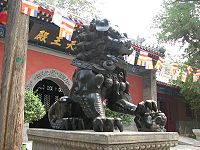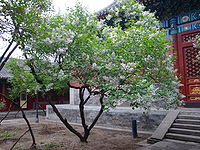
Fayuan Temple
Encyclopedia




Beijing
Beijing , also known as Peking , is the capital of the People's Republic of China and one of the most populous cities in the world, with a population of 19,612,368 as of 2010. The city is the country's political, cultural, and educational center, and home to the headquarters for most of China's...
, is one of the city's most renowned Buddhist temples.
History
The temple was first built in 645 during the Tang DynastyTang Dynasty
The Tang Dynasty was an imperial dynasty of China preceded by the Sui Dynasty and followed by the Five Dynasties and Ten Kingdoms Period. It was founded by the Li family, who seized power during the decline and collapse of the Sui Empire...
by Emperor Li Shimin, and later rebuilt in the Zhengtong Period (1436–1449) of the Ming Dynasty
Ming Dynasty
The Ming Dynasty, also Empire of the Great Ming, was the ruling dynasty of China from 1368 to 1644, following the collapse of the Mongol-led Yuan Dynasty. The Ming, "one of the greatest eras of orderly government and social stability in human history", was the last dynasty in China ruled by ethnic...
. The temple occupies an area of 6,700 square meters. The temple also contains a large number of cultural relics, including sculptures of ancient bronzes, stone lions, as well as gilded figures of the three Buddhas-Vairochana. The temple also features large number of Buddhist texts from the Ming and Qing dynasties.
Structure
It has a compact overall arrangement and buildings are arranged along the medial axis symmetrically. Main buildings there include the Gate of Temple, Heavenly King Hall, Main Hall, Hall of Great Compassion, Sutra Hall, and Bell and Drum Towers.On both sides of the Gate of Temple stand the Bell Tower and the Drum Tower respectively. The Main Hall, which is magnificent and sacred, houses Statues of Flower Adornment School's three saints: Vairocana Buddha, Manjusri, and Samantabhadra. The Hall of Great Compassion houses statues, carved stones, and artistic masterpieces. Among these statues there stand some of the most valuable statues in ancient China - Pottery Statue of Sitting Buddha of the Eastern Han Dynasty
Han Dynasty
The Han Dynasty was the second imperial dynasty of China, preceded by the Qin Dynasty and succeeded by the Three Kingdoms . It was founded by the rebel leader Liu Bang, known posthumously as Emperor Gaozu of Han. It was briefly interrupted by the Xin Dynasty of the former regent Wang Mang...
(25-220), Pottery-bottle Statue of Buddha of the Eastern Wu Dynasty (229-280), Stone Statue of Buddha of the Tang Dynasty
Tang Dynasty
The Tang Dynasty was an imperial dynasty of China preceded by the Sui Dynasty and followed by the Five Dynasties and Ten Kingdoms Period. It was founded by the Li family, who seized power during the decline and collapse of the Sui Empire...
(618-907), and Steel-cast Statue of Kwan-yin. Moreover, it also exhibits Buddhist scriptures, statues, and cultural relics presented by various countries.
Taiwan writer Li Ao
Li Ao
Li Ao , is a writer, social commentator, historian, and independent politician in the Republic of China .He is considered by many to be one of the most important modern Chinese essayists today, although critics have termed him an intellectual narcissist...
, who published a novel: "Martyrs' Shrine: The Story of the Reform Movement of 1898 in China" (another name is called "Fayuan Temple"), is about the beginning and the failure of the Hundred Days' Reform in later Qing Dynasty
Qing Dynasty
The Qing Dynasty was the last dynasty of China, ruling from 1644 to 1912 with a brief, abortive restoration in 1917. It was preceded by the Ming Dynasty and followed by the Republic of China....
. He was won the nomination of Nobel Prize
Nobel Prize
The Nobel Prizes are annual international awards bestowed by Scandinavian committees in recognition of cultural and scientific advances. The will of the Swedish chemist Alfred Nobel, the inventor of dynamite, established the prizes in 1895...
for Literature.

